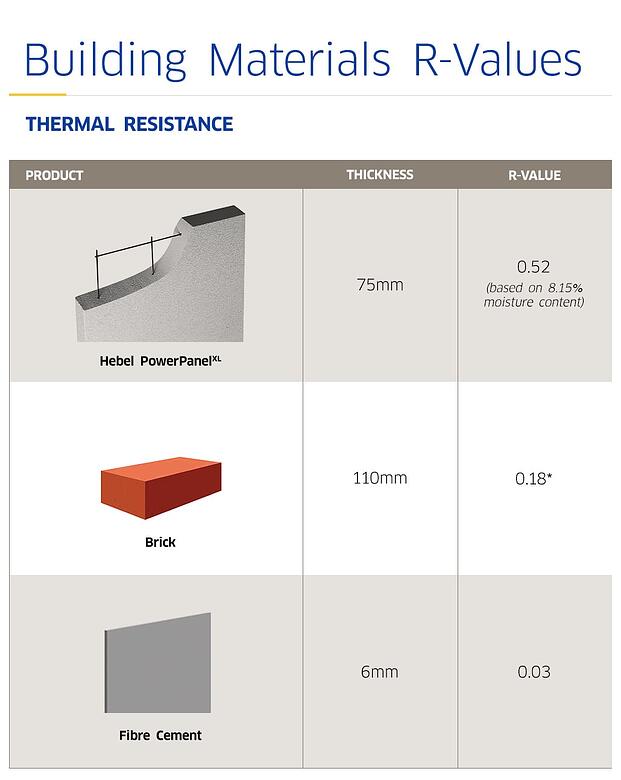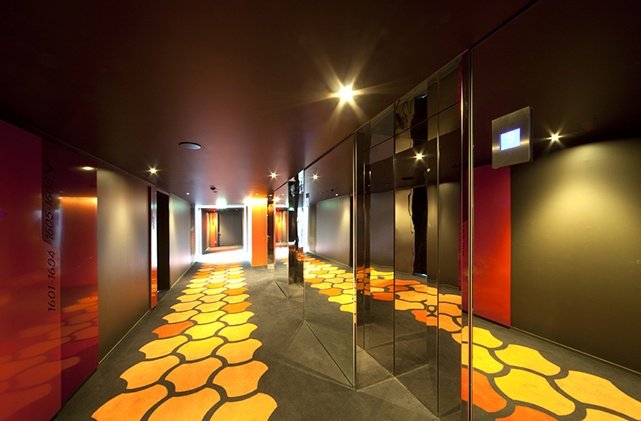You can’t completely stop the flow of heat but the rate at which it flows can be reduced when you build with materials that have a high resistance to heat flow. In other words, for comfortable living inside your home you want good insulation between the internal and external environments. That way you minimise reliance on heating and cooling and keep your energy costs and greenhouse emissions down.
Measuring the R-value of building materials
How well a building material withstands heat moving through it is measured in terms of thermal resistance, referred to as ‘R-value’. The greater the resistance to heat flow, the higher the R-value. It’s calculated on the thickness and bulk density (kg/m3) of the material and the rate at which it conducts heat. The greater the bulk density of a material, the lower its thermal resistance. Materials that are poor conductors of heat are better insulators because heat moves through them more slowly.
The table below shows the R-values of brick, Hebel PowerPanelXL and fibre cement which are used in external walls. Even though a standard 110mm brick is thicker than the 75mm Hebel PowerPanelXL panel, brick has poorer thermal resistance due to its greater bulk density compared to the Hebel. This indicates the role of thermal conductivity or the transfer of heat through a material and is influenced by different factors including its microstructure, composition, bulk density and size and structure of pores.1

The difference between the R-value of materials and the building system
The brick veneer or rendered Hebel PowerPanelXL wall cladding of an external wall plays a vital role in resisting heat flow but it’s not the only component of the wall that needs to be taken into account. Multiple components contribute to the thermal resistance of the wall. These components include the outside air surface, internal air spaces, insulation materials as well as fixings and the wall frame itself.
Collectively they form a building system or more specifically here a wall system and they’re used to calculate the total system R-value. The same approach applies to floors, roofs, windows and doors which are also building systems.
Below are examples of total R-values of two external wall systems – Hebel and brick veneer – both using double reflective foil insulation.
How R-values are used for home energy efficiency assessments
Under the National Construction Code building materials and systems need to achieve minimum levels of thermal performance – expressed in R-values – according to climate zone and elevation above or below 300metres. There are eight climate zones ranging from Zone 1 for the hottest to Zone 8 the coldest. Although each zone will have seasonal variations, there will be a predominant condition that needs to be addressed. For the Zone 1 rating the concern is how much energy is likely to be used to cool the home in summer and for Zone 8 it’s heating in winter. There will also be state and territory variations covered in the National Construction Code.
These R-values are important in the design of a new home which needs to achieve a minimum 6-star energy efficiency rating. This rating is an indicator of how much heating or cooling might be needed for comfortable living and is determined by an energy efficiency assessor. The assessment includes R-values of the building fabric (such as roof, walls, floors, windows and doors), location and orientation of the home, air movement and external colours.
CSR Hebel provides summer and winter total R-values for its external wall systems which are then referred to by the designer to determine the best Hebel system for the zone, and by the assessor for the energy efficiency rating.
Higher R-values for long term comfort
Building materials and systems with high R-values do a far better job of insulating your home than ones with low R-values. The choices you make at the design stage are ones that will have an impact on home comfort and energy usage year after year.
For more information on the thermal benefits of Hebel external wall systems for houses visit www.hebel.com.au. You’ll also find comprehensive information on energy efficiency in the Hebel Design and Installation Guide for Houses and Low Rise Multi Residential PowerPanelXL External Walls at www.hebel.com.au
Thermal Conductivity of Clay Bricks, M. Dondi et al, Journal of Materials in Civil Engineering, 16 [1] (2004) 8-14 by American Society of Civil Engineers.




